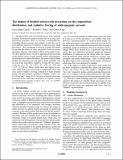| dc.contributor.author | Cohen, Jason Blake | |
| dc.contributor.author | Prinn, Ronald G. | |
| dc.contributor.author | Wang, Chien | |
| dc.date.accessioned | 2012-10-16T13:17:49Z | |
| dc.date.available | 2012-10-16T13:17:49Z | |
| dc.date.issued | 2011-05 | |
| dc.date.submitted | 2011-04 | |
| dc.identifier.issn | 0094-8276 | |
| dc.identifier.uri | http://hdl.handle.net/1721.1/74005 | |
| dc.description.abstract | Detailed urban-scale processing has not been included in global 3D chemical transport models due to its large computational demands. Here we present a metamodel for including this processing, and compare it with the use of the traditional approach of dilution of emissions into large grid boxes. This metamodel is used in a global 3D model to simulate the effects of cities around the world on aerosol chemistry, physics, and radiative effects at the global scale. We show that the biases caused by ignoring urban processing on the global values of total aerosol surface concentration, the total aerosol column abundance, the aerosol optical depth (AOD), the absorbing aerosol optical depth (AAOD), and the top of the atmosphere radiative forcing (TOA) respectively are +26 ± +26 ± [subscript 3[superscript 2]]%, +51 ± +26 ± [subscript 10[superscript 12]]%, +42 ± [subscript 8[superscript 10]]%, +8 ± [subscript 16[superscript 18]]%, and −0.27 ± [subscript 0.14[superscript 0.10]] W/m2. These results show that failure to consider urban scale processing leads to significantly more negative aerosol radiative forcing compared to when detailed urban scale processing is considered. | en_US |
| dc.description.sponsorship | United States. Dept. of Energy (Grant DE‐FG02‐94ER61937) | en_US |
| dc.description.sponsorship | National Science Foundation (U.S.) (Grant AGS‐0944121) | en_US |
| dc.description.sponsorship | Singapore. National Research Foundation | en_US |
| dc.description.sponsorship | Singapore-MIT Alliance. Center for Environmental Sensing and Monitoring | en_US |
| dc.language.iso | en_US | |
| dc.publisher | American Geophysical Union (AGU) | en_US |
| dc.relation.isversionof | http://dx.doi.org/10.1029/2011gl047417 | en_US |
| dc.rights | Article is made available in accordance with the publisher's policy and may be subject to US copyright law. Please refer to the publisher's site for terms of use. | en_US |
| dc.source | MIT web domain | en_US |
| dc.title | The impact of detailed urban-scale processing on the composition, distribution, and radiative forcing of anthropogenic aerosols | en_US |
| dc.type | Article | en_US |
| dc.identifier.citation | Cohen, Jason Blake, Ronald G. Prinn, and Chien Wang. “The Impact of Detailed Urban-scale Processing on the Composition, Distribution, and Radiative Forcing of Anthropogenic Aerosols.” Geophysical Research Letters 38.10 (2011). ©2011 American Geophysical Union | en_US |
| dc.contributor.department | Massachusetts Institute of Technology. Center for Global Change Science | en_US |
| dc.contributor.department | Massachusetts Institute of Technology. Joint Program on the Science & Policy of Global Change | en_US |
| dc.contributor.mitauthor | Cohen, Jason Blake | |
| dc.contributor.mitauthor | Prinn, Ronald G. | |
| dc.contributor.mitauthor | Wang, Chien | |
| dc.relation.journal | Geophysical Research Letters | en_US |
| dc.eprint.version | Final published version | en_US |
| dc.type.uri | http://purl.org/eprint/type/JournalArticle | en_US |
| eprint.status | http://purl.org/eprint/status/PeerReviewed | en_US |
| dspace.orderedauthors | Cohen, Jason Blake; Prinn, Ronald G.; Wang, Chien | en |
| dc.identifier.orcid | https://orcid.org/0000-0001-5925-3801 | |
| dc.identifier.orcid | https://orcid.org/0000-0002-3979-4747 | |
| mit.license | PUBLISHER_POLICY | en_US |
| mit.metadata.status | Complete | |
